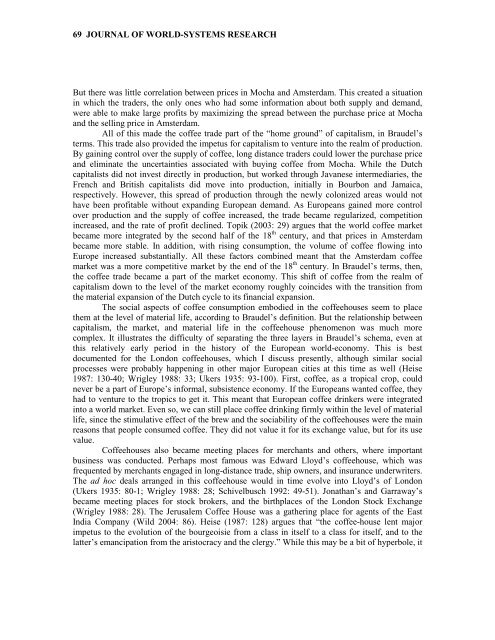Entire Volume 17 issue 1 - Journal of World-Systems Research ...
Entire Volume 17 issue 1 - Journal of World-Systems Research ...
Entire Volume 17 issue 1 - Journal of World-Systems Research ...
Create successful ePaper yourself
Turn your PDF publications into a flip-book with our unique Google optimized e-Paper software.
69 JOURNAL OF WORLD-SYSTEMS RESEARCH<br />
But there was little correlation between prices in Mocha and Amsterdam. This created a situation<br />
in which the traders, the only ones who had some information about both supply and demand,<br />
were able to make large pr<strong>of</strong>its by maximizing the spread between the purchase price at Mocha<br />
and the selling price in Amsterdam.<br />
All <strong>of</strong> this made the c<strong>of</strong>fee trade part <strong>of</strong> the “home ground” <strong>of</strong> capitalism, in Braudel’s<br />
terms. This trade also provided the impetus for capitalism to venture into the realm <strong>of</strong> production.<br />
By gaining control over the supply <strong>of</strong> c<strong>of</strong>fee, long distance traders could lower the purchase price<br />
and eliminate the uncertainties associated with buying c<strong>of</strong>fee from Mocha. While the Dutch<br />
capitalists did not invest directly in production, but worked through Javanese intermediaries, the<br />
French and British capitalists did move into production, initially in Bourbon and Jamaica,<br />
respectively. However, this spread <strong>of</strong> production through the newly colonized areas would not<br />
have been pr<strong>of</strong>itable without expanding European demand. As Europeans gained more control<br />
over production and the supply <strong>of</strong> c<strong>of</strong>fee increased, the trade became regularized, competition<br />
increased, and the rate <strong>of</strong> pr<strong>of</strong>it declined. Topik (2003: 29) argues that the world c<strong>of</strong>fee market<br />
became more integrated by the second half <strong>of</strong> the 18 th century, and that prices in Amsterdam<br />
became more stable. In addition, with rising consumption, the volume <strong>of</strong> c<strong>of</strong>fee flowing into<br />
Europe increased substantially. All these factors combined meant that the Amsterdam c<strong>of</strong>fee<br />
market was a more competitive market by the end <strong>of</strong> the 18 th century. In Braudel’s terms, then,<br />
the c<strong>of</strong>fee trade became a part <strong>of</strong> the market economy. This shift <strong>of</strong> c<strong>of</strong>fee from the realm <strong>of</strong><br />
capitalism down to the level <strong>of</strong> the market economy roughly coincides with the transition from<br />
the material expansion <strong>of</strong> the Dutch cycle to its financial expansion.<br />
The social aspects <strong>of</strong> c<strong>of</strong>fee consumption embodied in the c<strong>of</strong>feehouses seem to place<br />
them at the level <strong>of</strong> material life, according to Braudel’s definition. But the relationship between<br />
capitalism, the market, and material life in the c<strong>of</strong>feehouse phenomenon was much more<br />
complex. It illustrates the difficulty <strong>of</strong> separating the three layers in Braudel’s schema, even at<br />
this relatively early period in the history <strong>of</strong> the European world-economy. This is best<br />
documented for the London c<strong>of</strong>feehouses, which I discuss presently, although similar social<br />
processes were probably happening in other major European cities at this time as well (Heise<br />
1987: 130-40; Wrigley 1988: 33; Ukers 1935: 93-100). First, c<strong>of</strong>fee, as a tropical crop, could<br />
never be a part <strong>of</strong> Europe’s informal, subsistence economy. If the Europeans wanted c<strong>of</strong>fee, they<br />
had to venture to the tropics to get it. This meant that European c<strong>of</strong>fee drinkers were integrated<br />
into a world market. Even so, we can still place c<strong>of</strong>fee drinking firmly within the level <strong>of</strong> material<br />
life, since the stimulative effect <strong>of</strong> the brew and the sociability <strong>of</strong> the c<strong>of</strong>feehouses were the main<br />
reasons that people consumed c<strong>of</strong>fee. They did not value it for its exchange value, but for its use<br />
value.<br />
C<strong>of</strong>feehouses also became meeting places for merchants and others, where important<br />
business was conducted. Perhaps most famous was Edward Lloyd’s c<strong>of</strong>feehouse, which was<br />
frequented by merchants engaged in long-distance trade, ship owners, and insurance underwriters.<br />
The ad hoc deals arranged in this c<strong>of</strong>feehouse would in time evolve into Lloyd’s <strong>of</strong> London<br />
(Ukers 1935: 80-1; Wrigley 1988: 28; Schivelbusch 1992: 49-51). Jonathan’s and Garraway’s<br />
became meeting places for stock brokers, and the birthplaces <strong>of</strong> the London Stock Exchange<br />
(Wrigley 1988: 28). The Jerusalem C<strong>of</strong>fee House was a gathering place for agents <strong>of</strong> the East<br />
India Company (Wild 2004: 86). Heise (1987: 128) argues that “the c<strong>of</strong>fee-house lent major<br />
impetus to the evolution <strong>of</strong> the bourgeoisie from a class in itself to a class for itself, and to the<br />
latter’s emancipation from the aristocracy and the clergy.” While this may be a bit <strong>of</strong> hyperbole, it





